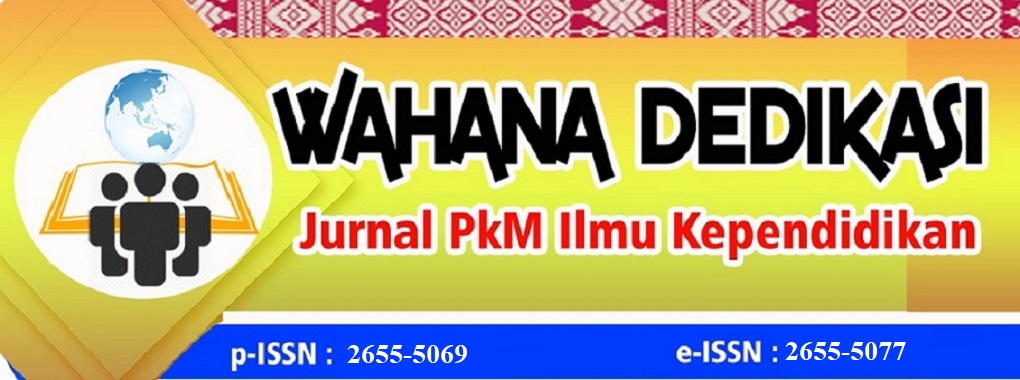Pendampingan Guru Pjok Dalam Upaya Penelusuran Bakat Olahraga Siswa
DOI:
https://doi.org/10.31851/dedikasi.v6i2.13123Abstract
Persoalan mendasar dalam keolahragaan di Indonesia hari ini adalah, tidak adanya jenjang pembinaan prestasi olahraga yang terstruktur dan berkelanjutan. Persoalan lainnya adalah belum adanya sistem identifikasi keberbakatan anak pada olahraga, keadaan ini menyebabkan potensi SDM Indonesia yang begitu banyak tidak tergali optimal sehingga menyulitkan untuk pencapaian prestasi olahraga yang maksimal. Oleh karena itu, perlu adanya upaya untuk pengenalan sistem identifikasi bakat yang mulai diperkenalkan di Indonesia. Hal ini sejalan dengan program Desain Besar Olahraga Nasional yang telah dicanangkan presiden pada tahun 2021 silam. Salah satu hal mendasar pada sistem DBON tersebut adalah pemanduan bakat bagi 250.000 anak Indonesia setiap tahunnya. Dan puncak prestasi Indonesia ditargetkan dapat diraih pada Olimpiade 2045 dengan Indonesia masuk peringkat 5 (lima) besar dunia. Melalui program kemitraan masyarakat dengan pendampingan Guru Pendidikan Jasmani Olahraga dan Kesehatan (PJOK) dalam Penggunaan Aplikasi Asesmen Talent Identification sebagai Upaya Penelusuran Bakat Olahraga Siswa, diharapkan persoalan di atas dapat diselesaikan secara bertahap. Melalui kegiatan ini diberikan pelatihan kepada guru untuk menggunakan Aplikasi Identifikasi Bakat Sekora dengan beberapa item tes antropometri, koordinasi motorik, dan penampilan fisik. Kemudian para guru nantinya akan mencobakan pelaksanaan tes tersebut kepada siswa masing-masing, sebagai deteksi bakat yang merupakan solusi persoalan yang pertama untuk memetakan program pembinaan (talent development). Kemudian, selanjutnya para guru juga akan menilai para siswa yang telah ikut aktif dalam cabang olahraga, untuk mengidentfikasi bakat sesuai spesifik cabor masing-masing yang merupakan solusi permasalahan kedua untuk menentukan keberbakatan anak sesuai spesifik olahraga masing-masing.References
Pion, J. (2015). The Flemish sports compass: From sports orientation to elite performance prediction. Ghent: Ghent University.
Norjali Wazir MRW,Van Hiel M, Mostaert M, Deconinck FJA, Pion J, Lenoir M (2019) Identification of elite performance characteristics in a small sample of taekwondoathletes. PLoS ONE 14(5):e0217358.https://doi.org/10.1371/journal. pone.0217358
Norjali R, Torfs M, Mostaert M, Pion J, Lenoir M. Predicting judo champions and medallists using statistical modelling. Archives of Budo. 2017; 13:161–7.
Pion J, Fransen J, Lenoir M, Segers V. The value of non-sport-specific characteristics for talent orientation in young male judo, karate and taekwondo athletes. Archives of Budo. 2014 Jun 20.
Pion JA, Fransen J, Deprez DN, Segers VI, Vaeyens R, Philippaerts RM, et al. Stature and jumping height are required in female volleyball, but motor coordination is a key factor for future elite success. The Journal of Strength & Conditioning Research. 2015 Jun 1; 29(6):1480–5.
Vandorpe B, Vandendriessche JB, Vaeyens R, Pion J, Lefevre J, Philippaerts RM, et al. The value of a non-sport-specific motor test battery in predicting performance in young female gymnasts. Journal of Sports Sciences. 2012 Mar 1; 30(5):497–505.https://doi.org/10.1080/02640414.2012.654399 PMID: 22263781
Kamasha Robertson, Johan Pion, Mireille Mostaert, Mohd Rozilee Wazir Norjali Wazir, Tamara Kramer, Irene Renate Faber, Pieter Vansteenkiste & Matthieu Lenoir (2018): A coaches’ perspective on the contribution of anthropometry, physical performance, and motor coordination in racquet sports, Journal of Sports Sciences, DOI: 10.1080/02640414.2018.1441941
Vandorpe, Barbara & Vandendriessche, Joric & Lefèvre, Jan & Pion, Johan & Vaeyens, Roel & Matthys, Stijn & Philippaerts, Renaat & Lenoir, Matthieu. (2010). The KörperkoordinationsTest für Kinder: Reference values and suitability for 6-12-year-old children in Flanders. Scandinavian journal of medicine & science in sports.21. 378-88. 10.1111/j.1600-0838.2009.01067.x.
Iivonen, Susanna & Sääkslahti, Arja & Laukkanen, Arto.(2015). A review of studies using the Körperkoordinationstest für Kinder (KTK). 8.
Kamasha Robertson, Johan Pion, Mireille Mostaert, Mohd Rozilee Wazir Norjali Wazir, Tamara Kramer, Irene Renate Faber, Pieter Vansteenkiste & Matthieu Lenoir (2018): A coaches’ perspective on the contribution of anthropometry, physical performance, and motor coordination in racquet sports, Journal of Sports Sciences, DOI: 10.1080/02640414.2018.1441941
Johan Pion*, Andreas Hohmann*, Tianbiao Liu, Matthieu Lenoir, Veerle Segers. Predictive models reduce talent development costs in female gymnastics. (2015) Journal of Sports Sciences, Submitted March 12th 2015
Olutende, O.M., Wekesa, J.S., Mogaka, E.S. and Kweyu, I.W., 2018. DISCRIMINANT Analysis Of Anthropometric And Biomotor Variables Among Groups Of Male University Athletes In Three SPORTS. European Journal of Physical Education and Sport Science.
Bloom BS (1985). Developing talent in young people. New York: Ballantine, 1985
Csikszentmihalyi M, Rathunde K, Whalen S (1993). Talented teenagers: The roots of success and failure. New York: Cambridge UniversityPress.
Bahtiar, 2014. Arah Masa Depan Pendidikan Jasmani & Olahraga: Mengembangkan Fundamental motor Kompetensi di Awal Tahun Apakah Paramount untuk Aktivitas Fisik seumur hidup
Mueller et al., 2015 Molinero, O., Salguero, A., Tuero, C., et al., (2006). Dropout from youth sports: relationship to gender, type of sport and level of competition. Journal of Sport Behavior, 29, 255-270.
Mewing M (2014). Talent Identification Conference “Identifying Champions” April 2nd – 3rd 2014. “Prospecting for Gold – a novel talentidentification and development approach at the Queensland Academy for Sport
Höner dan Votteler, 201Prognostic relevance of motor talent predictors in early adolescence: A group- and individual-based evaluation considering different levels of achievement in youth football 2016 Journal of Sports Sciences 34(24):1- 10DOI: 10.1080/02640414.2016.1177658
Downloads
Published
Issue
Section
License
Copyright (c) 2023 Atradinal, Romi Mardela, Ishak Aziz

This work is licensed under a Creative Commons Attribution 4.0 International License.
Authors who publish this journal agree to the following conditions:The author has the copyright and entitles the journal to the first publication with works that are licensed simultaneously under the Creative Commons Attribution CC BY License which allows others to share their work with the recognition of the authorship of the work and initial publications in this journal.
Â
The author can make separate additional contract agreements for the non-exclusive distribution of published journal versions of the work (for example, posting them to the institutional repository or publishing them in a book), with recognition of the initial publication in this journal.
Â
Authors are permitted and encouraged to post their work online (e.g., in institutional repositories or on their websites) before and during the delivery process because it can lead to productive exchanges, as well as quotes that are earlier and larger than published works





.png)



